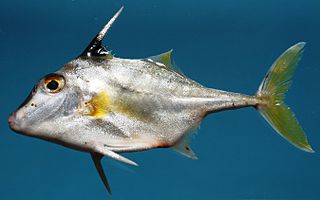
Tetraodontiformes, also known as the Plectognathi, is an order of ray-finned fishes which includes the pufferfishes and related taxa. This order has been classified as a suborder of the order Perciformes, although recent studies have found that it, as the Tetraodontoidei, is a sister taxon to the anglerfish order Lophiiformes, called Lophiodei, and have placed both taxa within the Acanthuriformes. The Tetraodontiformes are represented by 10 extant families and at around 430 species overall. The majority of the species within this order are marine but a few may be found in freshwater. They are found throughout the world.

Triacanthidae, commonly known as triplespines or tripodfishes, is a family of Indo-Pacific fishes. It is classified in the order Tetraodontiformes, along with the pufferfishes and the ocean sunfish. The family consists of seven species in four genera, in addition to three extinct genera that are only known from fossils.

The spikefishes are ray-finned fishes related to the pufferfishes and triggerfishes. They live in deep waters; more than 50 m (160 ft), but above the continental shelves. They are found in the Atlantic, Indian Ocean, and the west-central Pacific.
Cryptobalistes is an extinct genus of triplespine that lived during the early Oligocene epoch. It contains a single species, C. brevis that inhabited the seas around what is now Canton Glarus, Switzerland. It is thought to be closely allied with another triplespine from Glarus, Acanthopleurus. Cryptobalistes, Acanthopleurus, and Protacanthodes are thought to be basal members of the Triacanthidae.

Acanthopleurus is an extinct genus of marine triplespine that lived in the seas over what is now Europe during the early Oligocene epoch.

Lepidotrigla is a genus of marine ray-finned fishes belonging to the family Triglidae, the gurnards and sea robins. These gurnards are found in the Eastern Atlantic, Indian and Western Pacific Oceans.
Atrophacanthus is a monospecific genus of marine ray-finned fish belonging to the family Triacanthodidae, the spikefishes. The onlu species in the genus is Atrophacanthus japonicus, the upward-mouth spikefish, which is found in the Indo-West Pacific region.
Bathyphylaxis a genus of marine ray-finned fishes belonging to the family Triacanthodidae, the spikefishes. The fishes in this genus are found in the deep waters of the Indian and Pacific Oceans.

Hollardia is a genus of marine ray-finned fishes belonging to the family Triacanthodidae, the spikefishes. These demersal fishes are found in the Western Atlantic Ocean with one species being found in the Pacific Ocean.

Macrorhamphosodes is a genus of spikefishes native to the Indian and western Pacific Oceans.

Parahollardia is a genus of marine ray-finned fishes belonging to the family Triacanthodidae, the spikefishes. These demersal fishes are found in the Western Atlantic Ocean.
Paratriacanthodes is a genus of spikefishes found in the Indian and Pacific Oceans.

Minous, is a genus of marine ray-finned fishes, it is the only genus in the tribe Minoini, one of the three tribes which are classified within the subfamily Synanceiinae within the family Scorpaenidae, the scorpionfishes and their relatives. They are commonly known as stingfishes. They are found in the Indo-West Pacific.
Owstonia is a genus of marine ray-finned fish belonging to the family Cepolidae, the bandfishes. It is the only genus in the monotypic subfamily Owstoninae. They are found in deep waters of the Indian and Pacific Ocean.

Parascolopsis, the dwarf monocle breams, is a genus of marine ray-finned fishes belonging to the family Nemipteridae, the threadfin breams. These fishes are found in the Indo-Pacific region.
Canthigaster tyleri, also known as Tyler's toby, is a species of marine fish in the family Tetraodontidae.
Canthigaster figueiredoi, known as the Southern Atlantic sharpnose-puffer, is a species of marine fish in the family Tetraodontidae. It was first isolated from the east coast of South America, in the Atlantic Ocean.

Paratriacanthodes retrospinis is a marine bathydemersal fish species in the spikefish family.

Triacanthoidei is a suborder of ray-finned fishes belonging to the order Tetraodontiformes, which includes the pufferfishes, triggerfishes and related taxa. These benthic fishes are mainly found in the Indian Ocean with some of the spikefishes found in the Western Atlantic Ocean.

Hollardiinae is a subfamily of marine ray-finned fishes belonging to the family Triacanthodidae, the spikefishes. This small subfamily comprises two genera and a total of five species and all, except one species, are found in the tropical and subtropical waters of the Western Atlantic Ocean. The exception is found in the western and central Pacific Ocean.











